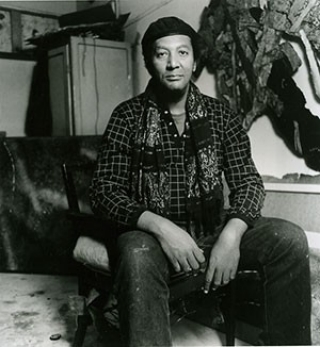Born 1935, Detroit, Michigan
Died 2005, New York City
Al Loving studied painting at the University of Illinois, Champaign, before earning his MFA from the University of Michigan in 1965. Moving to New York City in 1968, he took up residence at the famous Chelsea Hotel and soon installed himself in a studio on the Bowery, thanks to references from established artists like Claes Oldenburg. Following his successful 1969 solo show at the Whitney Museum of American Art, Loving exhibited widely and received multiple grants from the National Endowment of the Arts. He was also an influential educator, teaching at the City College of the City University of New York from 1988 to 1996.
Loving first became known for geometric paintings made up of multiple or shaped canvases. He showed such a piece in the Whitney exhibition Contemporary Black Artists in America (1971) alongside works by other artists such as Howardena Pindell. Organized in response to the Black Emergency Cultural Coalition’s demands for more inclusive programming, this exhibition was controversial, and fifteen artists withdrew from the show to protest its white organizer and his curatorial decisions. Shortly after this dispute over the politics of representation both within and behind the show, Loving abandoned his hardedged style. Remaining committed to abstraction, he took inspiration from vernacular textile traditions, spurred by the pioneering Whitney exhibition, Abstract Design in American Quilts (1971), which emphasized the formal design and aesthetic properties of traditional pieced quilts. He drew on childhood memories of his mother and grandmother quilting when he started to sew stained strips of canvas together in free-form compositions.
Untitled resembles the deconstructed “lazy gal” quilt style favored by many quilters of Gee’s Bend. Long strips of dyed canvas are pieced together in overlapping layers, descending in a jagged terminus. Mottled shades of indigo and pink, interrupted by bursts of sunny yellow dye—reminiscent of color field painting and the work of Washington School painter Sam Gilliam in particular—animate the informal, improvisatory composition. The soft forms of Loving’s torn and stitched-together canvases embody an experimental attitude toward both the traditional materials of painting and the protocols of the gallery space.
Jenevive Nykolak
Al Loving: Departures. New York: The Studio Museum in Harlem, 1986.
Siegel, Katy. Al Loving: Torn Canvas. New York: Gary Snyder Gallery, 2012.
